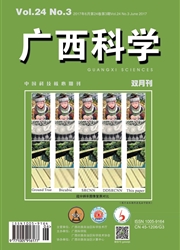

 中文摘要:
中文摘要:
【目的】通过对大明山南亚热带山地常绿阔叶林72个400m^2样地的调查,了解特大冰冻干扰对南亚热带山地常绿阔叶林树冠和林冠状况的影响。【方法】2009年,在大明山海拔934~1223m的范围内,按上、中、下坡设立3组调查样地,每一组样地包括24个20m×20m样方,对胸径≥5cm的林木进行调查,记录种名、胸径、树高、冠长、冠幅、座标及受损类型等。【结果】经统计,在调查的胸径≥5cm的2538株林木中,有1714株受到不同程度损伤,占总数的67.53%,其中轻度损伤占47.75%、重度损伤占19.78%。总体上,不同坡位的冠损状况相似,均以轻度损伤为主,但表现有所不同,上坡轻度损伤比例最小(40.94%),严重损伤的比例最高(26.49%);中坡与之相反,轻度损伤比例最大(52.38%),严重损伤比例最小(16.52%);下坡损伤比例最低。胸径影响树木的受损类型和程度,呈现出随着胸径的增加,树冠受损的比例逐渐增大,并在30~40cm径级(上坡)和40~81cm径级(中坡和下坡)达到最大值。断枝比例(包括断枝少和断枝多)随胸径增大而增大,而断梢和失冠则随胸径增大而减小。落叶树种比常绿树种受损更重。冰冻灾害后,林冠叶面积指数显著下降,散射透光系数和直射透光系数显著增加。【结论】特大冰冻干扰对大明山常绿阔叶林已造成严重影响,受冰冻灾害的长期影响,大明山常绿阔叶林的树冠和林冠状况发生了显著的变化,由半圆球形树冠演变为狭窄的圆柱形树冠,以适应冰冻干扰和气候变化的影响。
 英文摘要:
英文摘要:
【Objective】Through field investigation of 72 permanent plots(each 400m^2)of the south subtropical montane evergreen broad-leaved forest in Damingshan Nature Reserve of Guangxi province,this paper deals with the effects of a severe ice storm disturbance on the crown and canopy condition of south subtropical montane evergreen broad-leaved forest in Guangxi province.【Methods】In 2009,3 groups of plots were set up in the ice storm-damaged montane evergreen broad-leaved forest in Damingshan National Nature Reserve,with altitude ranged from 934 mto 1223m,and divided into upper slope,middle slope and lower slope,where each group was further divided into 40 subplots and each had the plot of 400m^2.Within each subplot,all trees that their diameter at breast height(DBH)was equal to or larger than 5.0cm were identified,mapped and tagged at breast height(1.3mfrom the base)with pre-numbered aluminum tags,and then the DBH,stem heights,crown length,crown width,damage type of these taged trees were measured.【Results】The evergreen broad-leaved forest of Damingshan National Nature Reserve were affected severely by the ice storm as the damaged trees accounted for 67.53%of the total individuals with DBH≥5.0cm.Among of them slightly damaged individuals accounted for 47.75%and severely damaged ones accounted for 19.78%.The ratio of slightly damaged trees was minimum at upper slope(40.94%)while it was maximum at middle slope(52.38%).On the contrary,the ratio of severely damaged individuals was maximum at upper slope(26.49%)while minimum at middle slope(16.52%).However,the ratio of damaged individuals at lower slope was the most low among the three slope positions.The DBH was a sensitive index influencing the type and extent of tree damage.The more larger the DBH was,the more severe damage the tree crown suffered.The ratio of broken branch(including slight branch loss and severe branch loss)increased as the DBH increasing,whereas the breakage within crown and whole-crown loss decreased with i
 同期刊论文项目
同期刊论文项目
 同项目期刊论文
同项目期刊论文
 期刊信息
期刊信息
